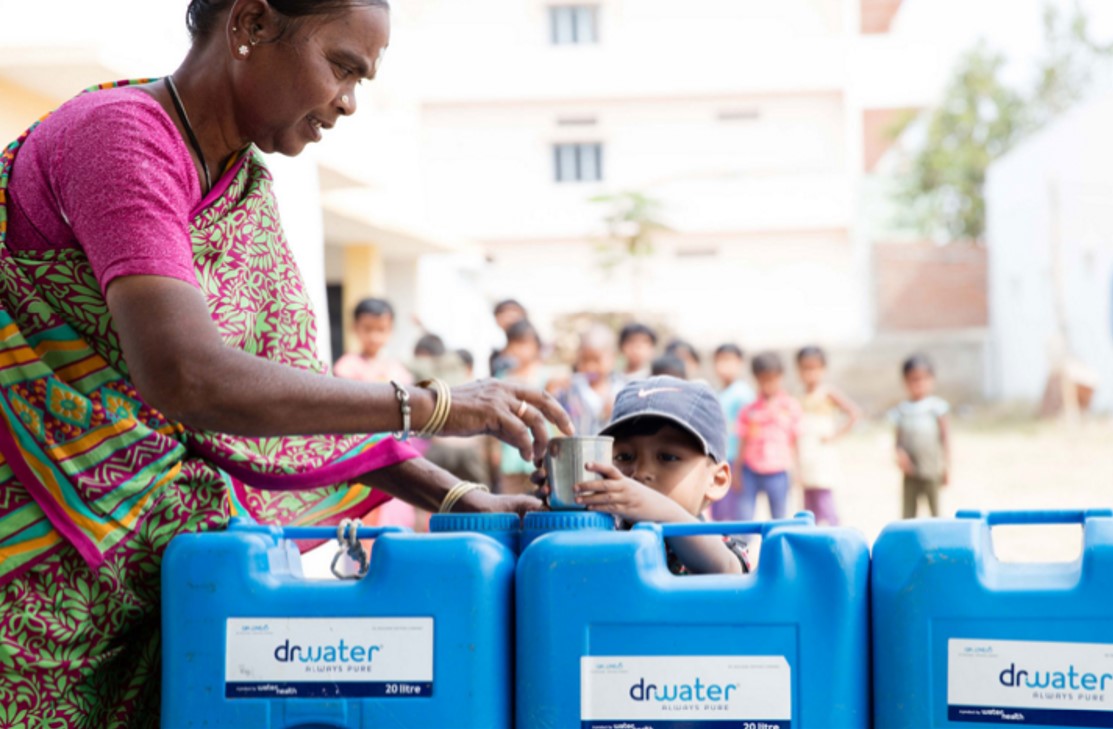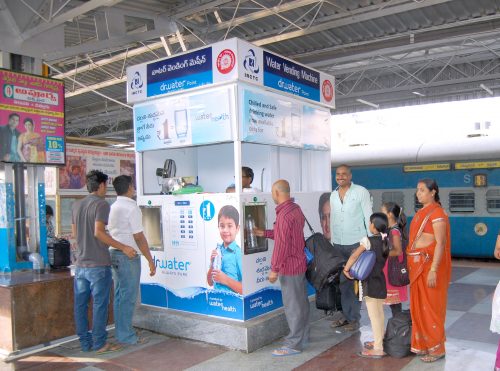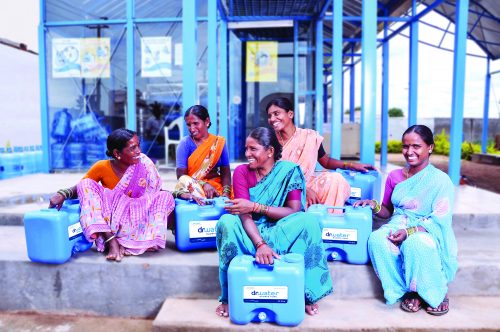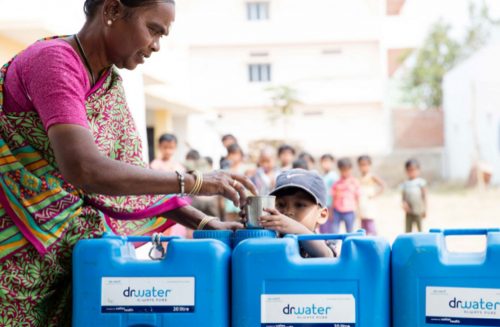Meet The Company Behind Drinking Water ATMs in 1800 Indian villages
Water ATM (also known as Water Vending Machine) is an automated water purification system which provides access to safe water access to people, round the clock. Water ATMs are the most supreme example of the miracles that science can do to provide the bounties of nature to mankind in plenty.

By Namrata Gulati Sapra
Whenever we run short of cash, we rush to an ATM to withdraw money and life’s beautiful again! What if there was a similar provision which one could rely on every time there was a paucity of water? Sounds too far-fetched? Well, WaterHealth India (WHIN), an initiative committed to supplying water to the areas affected by lack of access to clean and safe pure drinking water, is turning what seems like a distant dream, into reality by installing water ATMs in various parts of India.
If numbers are anything to go by, WHIN is carving out a momentous success story in 1,800 villages/urban local bodies in 36 districts [including 10 backward districts as classified by Government] of the states of Andhra Pradesh, Telangana, Karnataka, Gujarat, Tamil Nadu and Delhi, by installing over 450 water ATMs in India, which are providing clean and safe water access to over 6 million consumers.
What makes water ATMs such a path-breaking idea
Water ATM (also known as Water Vending Machine) is an automated water purification system which provides access to safe water access to people, round the clock. Water ATMs are the most supreme example of the miracles that science can do to provide the bounties of nature to mankind in plenty.
The machines have been designed in such a way that give it the ability to purify and dispense water, which makes for an ideal solution for high footfall locations like schools, railways stations, bus depots etc. That apart, there is an inbuilt chiller that can dispense old water during the blazing summer season. Another one of its many impressive features is that it has remote monitoring capabilities which facilitate automatic alerts that send out an indication every time the water reaches the refill level of the tank.
If you’re wondering about the water dispensing process, it’s as easy as pie! All one has to do is insert a coin and voila! The elixir of life, or water, as they call it, is ready for collection at Rs 5 per litre for non-bottles water, Rs 8 per litre for bottled water and Rs 10 for 20 litre of water.

Explains Vikas Shah, COO, Water Health International, “People belonging to the upper-middle class segment who are quality conscious and can afford to pay a higher price for water consumption, typically buy sealed bottled water that is sold directly at food kiosks or in trains/buses by packaged water companies. The mobile consumers belonging to the lower economic strata are unable to afford that water and are left with no other affordable and safe options.
They must thus spend anywhere between ₹15 – ₹20 to buy one litre of bottled water, which they cannot afford. This price is 3-4 times the price at which water will be available through the proposed WVMs (fixed at ₹5 per litre in case of the IRCTC WVMs), leading to considerable savings for the customers.”
Mr Shah goes on to enumerate other benefits that people are reaping from the project, “Health benefits due to improved safe drinking access: Mobile consumers (traveling consumers) who consume water from the various “free” water points/taps can never be very sure of the water quality standards being maintained; the quality is typically poor, both from a chemical as well as a microbiological perspective (i.e., does not meet the Indian drinking water ISO10500 standard).
Consuming such contaminated water can lead to waterborne diseases, thereby having an adverse health and economic impact on the poorest of poor traveling through these transport hubs. In addition, the supply of safe drinking water is usually very limited or not available at all. With the setting up of WVMs, people can be assured of the quality of water they consume thereby reducing the risks of negative health impacts.”
The icing on the cake is that project is generating livelihood in huge numbers, “WHIN recruits WVM operators locally from the areas of the railway and bus stations. The project, once operational, would ideally create employment opportunities for over 3,000 people. Each WVM employs 1-2 operator(s) depending on the hours of operation of the WVM. Another 600 – 800 jobs are created to ensure continuous operations and maintenance at the WVMs including quality and revenue assurance processes. Finally, there would be between 500 – 1,000 contract/temporary jobs created for the equipment installation including civil, electrical and plumbing works.” Time for the big question- does the machine have a cap? “There is no capping on the water dispensation at WVM!” He satiates our curiosity.
The Ripple Effect
WHIN installs, operates and maintains “micro-utilities” called WaterHealth Centres (WHCs) in the targeted communities. Here, contaminated water is treated through a six-stage purification process.
The water thus obtained is World Health Organization (WHO) quality safe drinking water that also meets the Indian drinking water standards (IS10500) and is dispensed under the brand name of “dr. water”.

“A major water contamination occurred in Gurjala village of Andhra Pradesh, India, in May 2010. While three people died from the tragedy that struck the rural folk, as many as 16 were affected by cholera. When the District Collector ordered for an inquiry, the only water tested to be safe for drinking during this outbreak was Dr Water produced by Gurjala’s WaterHealth Center (WHC), installed four years earlier”, shares the COO.
Alekhya, from the West Godavri District of Andhra Pradesh testifies, “Earlier, we lived in a village called Achanta and used to drink tap water which contained fluoride. My mother became a victim of Fluorosis and she fell very ill. Doctors advised her to drink purified water to stay alive. We came to know that ‘dr. water’ is the best quality drinking water and moved to Kavitam village 5 years back as the plant was set up there. Since then we are drinking dr. water and we are healthy.”
Swaroopa Rani, an Anganwadi teacher in the Maheshwaram Village of Telangana State shares her part of the story, “My family would fall ill frequently. Since we have started using ‘dr. water’, my family is healthier now. This has made the kids more regular to school. I want to provide the best education to my children.”

WHIN harbours a vision close to its heart, “As WaterHealth India steps into the second decade of its operation, the company has hastened its work towards its mission of serving 100 million people by 2020, by setting up over 125 Water Vending Machines (WVMs) in railways stations across India to provide mobile underserved consumers affordable options for safe and purified drinking water,” Vikas Shah concludes.
Like this story? Or have something to share?
Write to us: [email protected]
Connect with us on Facebook and Twitter.
NEW: Click here to get positive news on WhatsApp!

Similar Story

Would Your Parents Support You Taking Therapy? This Mental Wellbeing Survey Reveals an Unseen Change
An ITC Fiama survey on mental health shows 80% of Indians trust their parents to back them in seeking therapy, signalling a change in how its perceived by Gen Z, millennials, and their parents.
Read more >
If you found our stories insightful, informative, or even just enjoyable, we invite you to consider making a voluntary payment to support the work we do at The Better India. Your contribution helps us continue producing quality content that educates, inspires, and drives positive change.
Choose one of the payment options below for your contribution-
By paying for the stories you value, you directly contribute to sustaining our efforts focused on making a difference in the world. Together, let's ensure that impactful stories continue to be told and shared, enriching lives and communities alike.
Thank you for your support. Here are some frequently asked questions you might find helpful to know why you are contributing?


This story made me
-
97
-
121
-
89
-
167












